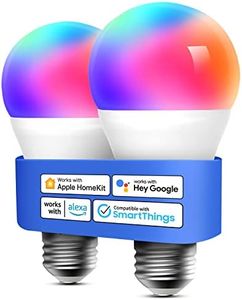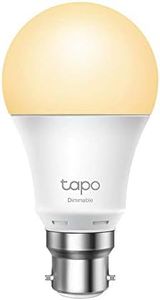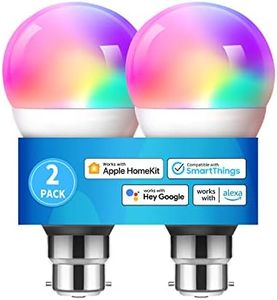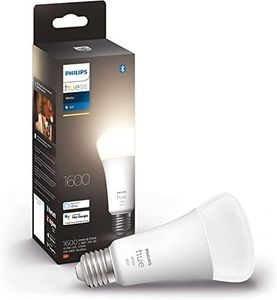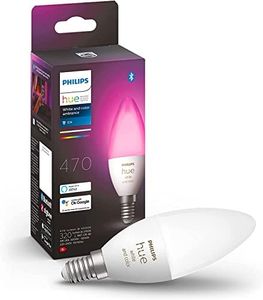We Use CookiesWe use cookies to enhance the security, performance,
functionality and for analytical and promotional activities. By continuing to browse this site you
are agreeing to our privacy policy
10 Best Smart Light Bulbs
From leading brands and best sellers available on the web.Buying Guide for the Best Smart Light Bulbs
Choosing the right smart light bulb can really enhance your home’s convenience, atmosphere, and even energy savings. Before you start shopping, think about where you’ll use the bulb and how you want to control it—do you just want to turn it on and off remotely, or are you interested in creating colorful mood lighting? Knowing your needs helps you focus on features that will truly benefit your lifestyle, making your smart bulb purchase much more satisfying in the long run.ConnectivityConnectivity refers to how your smart bulb communicates with your smartphone or smart home system, such as Wi-Fi, Bluetooth, or Zigbee. This is important because your choice determines compatibility with other devices and how easily you can control the bulb remotely. Wi-Fi bulbs connect directly to your household internet, making them simple to use and control from anywhere with an app, but they may take up bandwidth if you install many. Bluetooth bulbs don’t need a hub and are easy to set up but typically require you to be nearby. Zigbee bulbs often need a separate hub but can be more stable and efficient, especially if you plan to expand your smart home setup. Pick the connectivity option that matches your current devices, where you want to use the bulb, and your plans for future smart home expansion.
Brightness (Lumens)Brightness, measured in lumens, determines how much light a bulb emits. This matters because different rooms and tasks require different lighting levels. Typical values range from 400 lumens for soft accent lighting up to 1600 lumens or more for bright task lighting. For a cozy bedroom or decorative lamp, lower brightness might be best, while kitchens and workspaces benefit from brighter bulbs. Consider the size of your room and how you plan to use the light to choose the right brightness for your needs.
Color OptionsSmart bulbs may offer white-only, tunable white, or full-color options. This refers to whether the bulb can only show a standard white light, adjust between warm and cool whites, or change to millions of different colors. Color and tunable bulbs allow you to set different moods, match your circadian rhythms, or add fun effects for events. If you just want straightforward lighting, a white-only bulb is simpler and sometimes less expensive. If changing colors and adjusting ambiance are appealing, look for bulbs with wide tunable or color ranges.
Control MethodsControl methods describe how you interact with the bulb, such as smartphone apps, voice assistants, or physical switches. This is vital for convenience and accessibility. Some bulbs offer integration with smart speakers for voice control, while others work through their app. Think about who will use the light (kids, guests, tech-savvy users) and how hands-free you want the experience to be. Choose bulbs that support your preferred method of control and fit smoothly into your daily habits.
CompatibilityCompatibility means which smart home systems and platforms the light bulb works with, like Google Assistant, Amazon Alexa, or Apple HomeKit. This ensures you can easily control the bulb alongside other devices you own. Some bulbs work with many platforms, while others are specific to just one or two. Always check that the bulb is compatible with your current setup to take full advantage of your smart home’s features.
Energy EfficiencyEnergy efficiency indicates how much power the bulb uses and how long it lasts. This is important for lowering your electricity bills and reducing waste. Most smart bulbs use LED technology, which is more efficient and lasts much longer than traditional bulbs. When choosing, look for energy ratings or estimated yearly energy costs—more efficient bulbs are especially valuable if you’ll have many in use or they’ll be on for long periods.
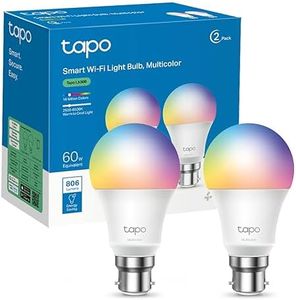
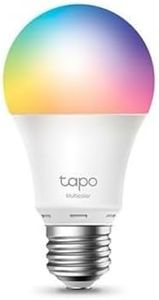

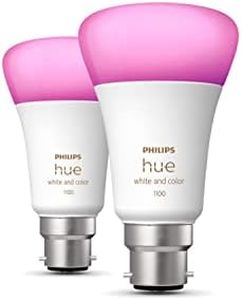
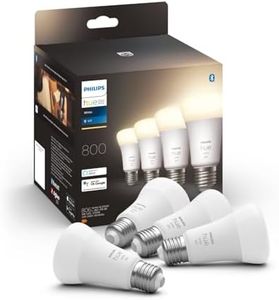
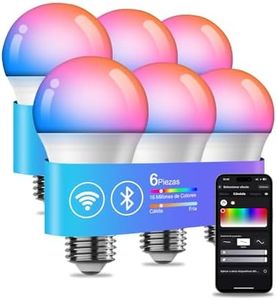
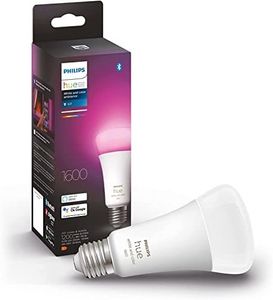

![Philips Hue New White Ambiance Smart Light Bulb 2 Pack 75W - 1100 Lumen [E27 Edison Screw] with Bluetooth. Compatible with Alexa, Google Assistant and Apple Homekit.](https://images-proxy.bestreviews.guide/8e6u1rUQ_gMyiBiNgmBG5xojW5o=/0x300/https://m.media-amazon.com/images/I/414ULO1F0ML._AC_CX679_.jpg)
